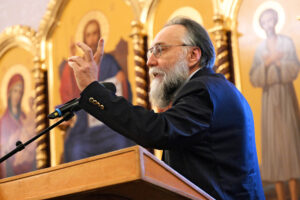Misunderstood Radicals
The German New Right

“German conservatism is a victim of fascism.” With this pithy statement the Swiss essayist, organizer, agitator, and doctor of philosophy Armin Mohler (1920–2003) summarized in 1962 an entire political project aimed at rehabilitating fascist-aligned thinkers by cleansing them of their Nazi entanglements.1 Often described as a “spiritual father” of the New Right, Mohler might be more aptly characterized, if somewhat anachronistically, as the arch-influencer of the Germanophone New Right—and his influence only grew after his death.
With his 1950 book The Conservative Revolution in Germany: 1918–1932, Mohler parlayed his position from officially neutral Switzerland to cast the proponents of the Neue Rechte (the New Right) as the inheritors of a conservative tradition purportedly untainted by fascism.2 Mohler separated a body of conservative Weimar-era thinkers from direct links to National Socialism by portraying them as dissenting conservatives. This group of intellectuals was—as Mohler’s narrative goes—victimized by political extremists associated with National Socialism. This construction, peddled by a Swiss citizen with solid fascist credentials, played a pivotal role in whitewashing strands of fascist-adjacent thinking in Germany after 1945. Examining Mohler’s role in the Neue Rechte’s foundational myth clarifies common misunderstandings that have led to underestimating the New Right’s potential radicality today.
The Neue Rechte regards itself as the intellectual vanguard of the post-fascist far right.3 The European New Right more broadly has always been a well-networked transnational movement, with especially close ties between the German-speaking Neue Rechte and the French-speaking Nouvelle Droite, but this essay focuses on one figure with particular influence on the Neue Rechte in Germany, Austria, and the German-speaking parts of Switzerland. What is commonly known as the New Right in the US context is different: It encompasses an insurgent movement within the Republican Party culminating in Ronald Reagan’s first election in 1980.4 The influence of the European New Right is vaster. It has played a significant role in paving the way for the xenophobic politics of the far-right Alternative for Germany (AfD), the Swiss People’s Party (SVP), and the Freedom Party of Austria (FPÖ), and understanding its political ambitions and historical vision is urgent for countering these antidemocratic forces. This New Right is a sustained intellectual project designed to harvest the ideological resources of dissident strands of fascism with the goal of building a new fascist-adjacent politics suitable to achieving electoral success in democratic settings.
The life of Mohler, as a guiding light of the New Right, traces a narrative arc across multiple generations of such thinking. Although research into Mohler and his networks is currently flourishing in Germany, political scientists still often mischaracterize the New Right’s intellectual project, describing the group as a hinge that links established conservative parties and the radical right.5 But this type of portrayal, by relying on an often-implicit spectrum that places fascism at one extreme, frequently disregards the complex internal fissures within fascist and fascist-adjacent thinking.
A new understanding is needed. The New Right does not attempt to resurrect fascist thinking, nor does it cultivate neo-Nazi aspirations. To describe it this way is to misconstrue the nature of its radicality. The New Right is better understood as an intellectual project designed to identify and revive dissident strands of thinking that previously proved to be too radical for fascism in power. The New Right is deeply concerned with its own history, and it mines that history to salvage and reinvigorate strands of fascist-adjacent thinking. The rest of us discount the movement’s intellectual complexity at our peril.
In an influential 2007 book, Tamir Bar-On described proponents of the New Right as “anti-fascist fascists.”6 The dynamics of early fascism show that his peculiarly contradictory locution is not a post–World War II invention. The origins of the myth of antifascist fascism can be traced to ideological conflicts within National Socialism, especially once it ruled. What Mohler called the “Conservative Revolution” played a significant role in the postwar laundering of dissident strands of fascist thinking. My thesis builds on Mohler’s narrative but reverses the political valence he associated with its protagonists. Where Mohler portrayed a group of conservatives working to deradicalize National Socialism, I see a group of thinkers who thought they had been deradicalized by their interaction with National Socialism in power.
Fascism’s Promiscuity
National Socialism itself was complex. Roger Griffin, one of the leading experts on the history of fascism, describes fascism in general as ideologically “promiscuous.”7 In his account of the origins of National Socialism, the intellectual historian George Mosse describes Nazi racism as a “scavenger ideology.”8 Promiscuous and scavenging, fascism demonstrates a remarkable ability to hold contradictions in tension without the need to alleviate them. If anything, fascism heightens logical tensions because of its flexibility. In the pursuit of concrete projects, it draws strategically on diverse ideological resources in order to adapt to particular situational needs—including, where necessary, by attenuating its radicality. Thanks partly to its polymorphism, it intentionally casts a wide net into which diverse political agents can project their unique political visions. When National Socialism came to power in January 1933, it had to negotiate a complex ideological space inhabited by a broad range of thinkers arrayed across the ethnonationalist spectrum. The cultivation of disparate, abstract ideological positions would often clash with the demands of political practice. Even in their pursuit of antisemitic persecution, decision-makers with the Nazi Party would at times adjust the pace of its implementation out of concern over domestic unrest and damage to Germany’s international standing. Many radical intellectuals within the party experienced these tactical considerations as a form of moderation.9
As Mosse’s intellectual history of National Socialism’s origins shows, the ethnonationalists active in Weimar Germany included a grab-bag of loosely aligned thinkers.10 At times they shared overlapping concerns—for example, defending their “race” or “ethnic community” from purported degeneration—yet they often cultivated highly niche agendas, ranging from white-supremacist eugenics, “spiritual” antisemitism focused on removing Jewish influence from German culture, the virtues of training the body, German-language purification, valorizing the German landscape, and Nordic nature cults.11 This thought collective produced an extraordinary amount of printed material, and loosely aligned groups churned out both minor and major journals featuring unique combinations of offerings from the ethnonationalist buffet. Despite this diversity, this broad group by and large willingly aligned itself with National Socialism in 1933. What happened next was a highly complex process of ideological splintering under bureaucratic conditions—and it did not always foster the most extreme position.12
National Socialism and the Force of Deradicalization
During this phase of promiscuous openness, many ambitious intellectuals—artists, writers, academics—felt drawn to a movement that intentionally tried to attract competing ideological forces. In his 1970 book Germans and Jews, Mosse argues that after aligning with National Socialism, many “intellectuals found themselves part of an organic world view which had tamed their activism.”13 Mosse indicates that, under the demands of fascist state formation—in particular Führerprinzip, which granted Hitler absolute authority—National Socialism underwent a relative ideological contraction as it focused on building a single ethnic community through education, administration, and culture. The historian Claudia Koonz documents how the Nazi state discouraged the expression of violent antisemitism in the first years of its rule.14 Many ethnonationalist thinkers saw their being sidelined by it as imposing a form of deradicalization on their own ambitions. As a result, many moved away from National Socialism once it was in power because they found little room to contribute their own visions. This process disheartened Ernst Jünger, Gottfried Benn, Hans Grimm, and Martin Heidegger.15
Identifying this taming dynamic and this disenchantment is absolutely critical to understanding the longevity of fascist ideas. At that point, the seeds of a bitter irony were sown, and the New Right then exploited it to launder a radical tradition and repackage it as anti-fascist. Falling out of favor with National Socialism, whatever the precise reasons, afforded some intellectuals an inadvertent advantage during denazification. After 1945, dissident academics—even those who criticized fascism from the right—could reframe their disputes with fascism in practice as a form of resistance or as ethically grounded dissent about what the Nazi Party had become, as opposed to what it should have been.16 Internecine feuds among adherents to a fascist and ethnonationalist project could now be cast to show that a particular individual had many Nazis as enemies and, hence, must be reliably anti-Nazi.
Although the concrete implementation of denazification policies varied significantly in the British, French, American, and Soviet occupation zones, the effort is widely regarded as having failed in the occupation zones in West Germany. In a standard work on the topic, the historian Lutz Niethammer refers to that process as that of a “bystander factory” that produced what were known even at the time as “Persilscheine,” Persil certificates,17 named after the popular laundry detergent brand. Bearers became, as it were, cleansed of any political stains. At a time when there was little interest in pursuing large-scale justice, securing a voucher of political hygiene was not overly difficult. The intellectual genesis of the contemporary New Right is rooted in a denazification process that made essentially cosmetic changes. Mohler exploited the mechanisms of this superficial reform.
The Arch-Influencer of the New Right
German-language scholarship on Mohler is flourishing at the moment. The historian Maik Tändler has performed the valuable service of recently producing a detailed intellectual biography. Prior to its publication in June, the only book-length biography of Mohler was a hagiographic work produced by the far-right German publishing house Verlag Antaios.18 Tändler’s extensive research describes, among other things, the origins of the myth of the Conservative Revolution.
In February 1942, Mohler, then a student at the University of Basel while on leave from Swiss military service, crossed the border into Germany in an attempt to enlist in the SS. Although the Nazis did not deem him fit for this purpose, they tolerated his presence and initially lodged him at a home for Nazi-aligned Swiss Germans in Stuttgart. He was permitted to study in Berlin in the fall of 1942. He returned to Switzerland at the end of the year, frustrated at his inability to establish himself politically in Germany. He crossed the border back into Switzerland illegally and was arrested for deserting from military service. A judge sentenced him to one year in prison.
Mohler resumed his studies in Basel in 1944 and completed a dissertation in philosophy in June 1949 based on his analysis of the history of German conservatism. Under a complicated set of circumstances documented by Tändler, the renowned German philosopher Karl Jaspers, who had been teaching at the University of Basel since 1948, agreed to supervise Mohler’s dissertation. German-speaking universities have long had a two-tier doctoral system, with one tier reserved for vanity dissertations by individuals not intending to pursue an academic future, many with political ambitions instead. Mohler was one of them. In his correspondence to Mohler, Jaspers offered a relatively harsh assessment of Mohler’s dissertation. He expressed suspicion about its political tone, yet he permitted it to pass academic muster. In comments to Mohler, he wrote off the work as politically harmless, even while characterizing it as a “large-scale denazification” of the thinkers it dealt with.19 The notion of “Conservative Revolution” thus served as a sort of intellectual Persilschein. Jaspers’ ultimate blessing turned out to be something of a public-relations coup for Mohler. Being associated with such an esteemed thinker granted Mohler intellectual legitimacy. And since Jaspers had been one of the most important public voices advocating that Germany confront its collective guilt after World War II, his imprimatur imparted a gleam of anti-fascist credentials to Mohler.
That key phrase Mohler adopted in his dissertation, “Conservative Revolution,” had already been in circulation, applied to a disparate group of thinkers who never saw themselves as part of any school or movement. They shared antidemocratic tendencies, and Mohler regarded them as having resisted the decadence of Weimar-era democracy.20 According to him, they had created a body of thought that was co-opted by the Nazis. Mohler cast them as a force of moderation attempting to temper a radical movement purportedly in the hands of a few zealots.
Mohler published the dissertation in 1950 and, by the standards of a scholarly publication, the work received a strong public response. The idea of the “Conservative Revolution” clearly fulfilled a nostalgic longing in the German public sphere. Again, Mohler’s tacit claim to Swiss neutrality and his distance from German discourses about guilt—however threadbare all that might have been—served as a powerful tool in a climate that required the evocation of only thin alibis. His thesis enabled Mohler to repackage a large group of fascist-adjacent thinkers for safe consumption by a nostalgic German public.
Tändler documents the publication of around 36 contemporary reviews of the book. While some reviewers immediately recognized it as a dangerous work of fascist apologetics, part of the conservative response was marked by strategic nuance and seemed more attentive to the book’s status as an event. Conservative reviewers often disagreed with details in Mohler’s overarching narrative yet deferred to the project’s general intentions. The subsequent scholarly reception has been consistently critical. While the phrase “Conservative Revolution” still circulates, critics such as Stefan Breuer have long called for it to be struck from the annals of history,21 arguing that its very use passively replicates Mohler’s whitewashing.
After the publication of The Conservative Revolution, Mohler excelled as a networker and agitator. Serving as Ernst Jünger’s personal secretary, he built up a valuable set of contacts. Mohler and Carl Schmitt produced a copious personal correspondence. Then, while working as a journalist in France, Mohler built up his network among the nascent forces that eventually became the French Nouvelle Droite. In 1964, he took over the leadership of the conservative Carl Friedrich von Siemens Foundation, and directed it until 1984. All the while, he publicly embraced evermore-radical positions and associated openly with far-right entities and positions. In 1995, Mohler publicly declared, “I am a fascist,” though he qualified the declaration with a number of tedious and coquettish caveats about the nature of the fascism he espoused.22 This open embrace of fascism presents less thorny interpretive issues than the earlier phases of his career. But it was a telling political move for a skilled self-promoter—especially one whose legacy has only grown recently, with the electoral victories of far-right and ethnonationalist parties in Austria, Germany, and Switzerland.
The Future of Fascisms Past
As a sophisticated intellectual movement, the New Right navigates with agility the limits of acceptable political discourse while continually pushing those limits forward by disavowing any association with National Socialism. This repudiation should not be dismissed as a mere pretext, but instead interrogated as a strategy. Never mind whether the New Right is more or less dangerous than an openly neo-Nazi movement. Such questions ultimately distract from the New Right’s subtle long-term political strategy, which—as the case of Mohler makes clear—involves tiresome rounds of peekaboo between fascist declarations and disavowals. The scholarship on fascism risks becoming a parasite that latches on to its object of analysis. Yet the political task of confronting the New Right is urgent.
Over the last decade, there have been cycles of often unproductive discussions about the nature of fascism, many focused on the United States. Paying attention to the New Right’s complex historical constitution within the polymorphous structures of historical fascism should shift the terms of the discussion. The implicit point of all this talk often seems to be to identify a worst-case scenario, what might or might not have happened, what might or might not happen still, in a particular here or there. But the New Right has already demonstrated that far-right political practice has long been pursuing other concrete and intellectual targets. Its adherents are sophisticated students of their own history. The forces that seek to counter the rise of fascist-adjacent politics today must become equally sophisticated in understanding the many facets of fascism.
Adam Knowles is a senior lecturer in the Department of Philosophy at the University of Zurich.
- Armin Mohler, “Konservativ 1962,” Der Monat 14, no.163 (April 1962): 23-29, 23. ↩︎
- Armin Mohler and Karlheinz Weissmann, Die konservative Revolution in Deutschland 1918-1932: Ein Handbuch (Darmstadt: Wissenschaftliche Buchgesellschaft, 1999 [1950]). ↩︎
- Cas Mudde, The Far Right Today (Wiley, 2019). There is an unfortunate paucity of English-language literature on Mohler, especially given a recent proliferation of work in German. See Roger Woods, Germany’s New Right as Culture and Politics (Palgrave Macmillan, 2007). ↩︎
- Donald T. Critchlow, The Conservative Ascendancy: How the Republican Right Rose to Power in Modern America (University Press of Kansas, 2011). ↩︎
- Wolfgang Gessenharter makes this claim in “Neue radikale Rechte, intellektuelle Neue Rechte und Rechtsextremismus: Zur theoretischen und empirischen Neuvermessung eines politisch-ideologischen Raumes,” in Rechtsextremismus und Neue Rechte in Deutschland, eds. Wolfgang Gessenharter and Helmut Fröchling (Leske + Budrich Verlag: 1998). ↩︎
- Tamir Bar-On, Where Have All the Fascists Gone? (Ashgate, 2007), 90. ↩︎
- Roger Griffin, “Review of David Roberts, Fascist Interactions: Proposals for a New Approach to Fascism and Its Era,” European History Quarterly 47, no. 2 (2017): 379-381, 380. ↩︎
- George L. Mosse, The Crisis of German Ideology: Intellectual Origins of the Third Reich (Grosset & Dunlap, 1964), vii. ↩︎
- To a certain extent, the complexity of the Nazi state structure helped to accommodate these contradictions in competing spheres of competence. Two classic works deal with that in different ways: Ernst Fraenkel, The Dual State: A Contribution of the Theory of Dictatorship, trans. E.A. Shils, with assistance from Edith Lowenstein and Klaus Knorr (Oxford University Press, 2017 [1941]) and Franz Neumann, Behemoth: The Structure and Practice of National Socialism, 1933–1944 (Ivan R. Dee, 2009 [1942]). ↩︎
- For another detailed overview in English, see Guy Tourlamain, Völkisch Writers and National Socialism: A Study of Right-Wing Political Culture in Germany, 1890–1960 (Peter Lang AG, 2014). ↩︎
- Johann Chapoutot, The Law of Blood: Thinking and Acting as a Nazi (Harvard University Press, 2018). See also: Fritz Stern, The Politics of Cultural Despair: A Study in the Rise of the Germanic Ideology (University of California Press, 1961) and Jeffrey Herf, Reactionary Modernism: Technology, Culture, and Politics in Weimar and the Third Reich (Cambridge University Press, 1984). ↩︎
- Ian Kershaw documents how Hitler did not always foster the most extreme proposal in internal decision-making in The Nazi Dictatorship: Problems and Perspectives of Interpretation, 4th ed. (Bloomsbury, 2015 [1985]), 91. ↩︎
- George L. Mosse, Germans and Jews: The Right, the Left, and the Search for a “Third Force” in Pre-Nazi Germany (H. Fertig, 1970), 168. ↩︎
- Claudia Koonz, The Nazi Conscience (Belknap, 2003). ↩︎
- Alice Yaeger Kaplan demonstrates that this is a common cycle for fascist-leaning creative intellectuals in Reproductions of Banality: Fascism, Literature, and French Intellectual Life (University of Minnesota Press, 1986). ↩︎
- A. Dirk Moses, German Intellectuals and the Nazi Past (Cambridge University Press, 2007) and Jan-Werner Müller, Another Country: German Intellectuals, Unification and National Identity (Yale University Press, 2000). ↩︎
- Lutz Niethammer, Die Mitläuferfabrik: Die Entnazifizierung am Beispiel Bayerns (Dietz, 1982). ↩︎
- Maik Tändler, Armin Mohler und die intellektuelle Rechte in der Bonner Republik (Wallstein Verlag, 2025). I demur at the need to cite the hagiographic far-right book. It is analyzed in detail in Volker Weiß, Die autoritäre Revolte: Die Neue Rechte und der Untergang des Abendlandes (Klett-Cotta, 2017). See also the contributions by Phillip Becher and Cenk Akdoganbulut in Rechtsextrem: Biografien nach 1945, eds. Gideon Botsch, Christoph Kopke, and Karsten Wilke (De Gruyter, 2023). ↩︎
- The circumstances of Jaspers’ involvement and his assessment of the dissertation are detailed in Tändler, 32-35. ↩︎
- In a work that is often characterized as the counterpart to Mohler’s handbook, Kurt Sontheimer documents the widespread nature of these antidemocratic tendencies: Antidemokratisches Denken in der Weimarer Republik: Die politischen Ideen des deutschen Nationalismus zwischen 1918 und 1933 (Deutscher Taschenbuch–Verlag, 1992 [1962]). ↩︎
- Stefan Breuer, Anatomie der konservativen Revolution (Wissenschaftliche Buchgesellschaft, 1993). ↩︎
- Fred David and Armin Mohler, “Ich bin ein Faschist,” Leipziger Volkszeitung, November 25, 1995. ↩︎


